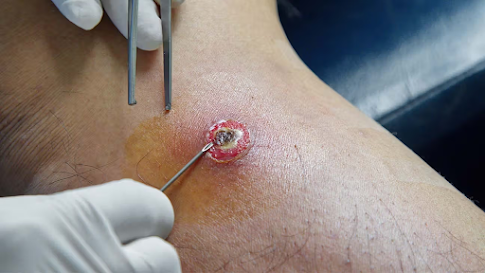Incision and Drainage Best Practices for Quick Healing
Incision and drainage (I&D) is a common procedure used to treat abscesses—localized infections that lead to the accumulation of pus. Proper care following an I&D is essential to ensure quick healing and minimize the risk of complications. This guide will explore best practices to promote healing after an Incision and Drainage of Abscesses in Dubai procedure.
Understanding the Incision and Drainage Procedure
Before delving into best practices, it’s crucial to understand what the I&D procedure entails:
- Assessment: A healthcare provider evaluates the abscess, determining its size, location, and severity.
- Anesthesia: Local anesthesia is typically administered to minimize discomfort during the procedure.
- Incision: A small incision is made in the abscess to allow pus to drain out effectively.
- Drainage: The healthcare provider removes pus and debris, cleaning the cavity thoroughly.
- Dressing: The incision is then dressed to protect it from infection and promote healing.
Understanding these steps helps you appreciate the significance of post-procedure care.
Immediate Post-Procedure Care
Effective immediate care following an I&D can significantly impact recovery:
1. Rest and Recovery
- Avoid Strenuous Activity: Rest is crucial immediately after the procedure. Avoid strenuous activities or heavy lifting that could strain the incision site.
- Positioning: If possible, keep the affected area elevated to reduce swelling.
2. Pain Management
- Use Pain Relief Medication: Over-the-counter pain relievers like acetaminophen or ibuprofen can help manage pain. Follow the provider’s recommendations on dosage.
- Cold Compress: Applying a cold pack to the area for 15-20 minutes can help reduce swelling and numb discomfort.
Wound Care
Proper wound care is vital for preventing infection and promoting quick healing:
1. Keeping the Wound Clean
- Gentle Cleaning: Clean the incision site gently with mild soap and water as advised. Avoid scrubbing the area.
- Avoid Moisture: Keep the incision dry, particularly during the first 24-48 hours.
2. Dressing Changes
- Change Dressings Regularly: Change the dressing as directed, typically whenever it becomes wet or soiled. This prevents moisture buildup, which can lead to infection.
- Use Sterile Materials: Always use sterile gauze and dressings to cover the incision.
3. Observe for Signs of Infection
- Monitor the Incision: Watch for increased redness, swelling, warmth, or any discharge from the incision. Report any concerning symptoms to your healthcare provider.
Hygiene Practices
Maintaining good hygiene is crucial for preventing complications:
1. Hand Hygiene
- Wash Hands Thoroughly: Wash your hands with soap and water before and after touching the wound or changing dressings. This minimizes the risk of introducing bacteria.
2. Avoid Soaking the Wound
- No Baths or Swimming: Refrain from soaking the incision in baths, hot tubs, or swimming pools until it has healed to reduce the risk of infection.
Nutrition and Hydration
Proper nutrition and hydration can significantly impact healing:
1. Stay Hydrated
- Drink Plenty of Water: Staying hydrated helps support the body’s healing processes and maintains optimal blood circulation.
2. Balanced Diet
- Nutrient-Rich Foods: Consume a well-rounded diet rich in protein, vitamins, and minerals. Foods high in vitamin C and zinc can enhance tissue repair and boost the immune system.
Follow-Up Care
Regular follow-up appointments are essential for monitoring recovery:
1. Schedule Follow-Up Visits
- Attend Follow-Up Appointments: Ensure you attend any scheduled follow-up visits. Your healthcare provider will assess the healing process and address any concerns.
2. Discuss Concerns
- Communicate Any Issues: If you have any questions or experience unusual symptoms during your recovery, contact your healthcare provider immediately.
Lifestyle Modifications
Making certain lifestyle adjustments can promote faster healing:
1. Avoid Smoking
- Smoking Impairs Healing: Smoking can impair circulation and slow down healing. If possible, reduce or eliminate smoking during your recovery.
2. Limit Alcohol Consumption
- Avoid Alcohol: Alcohol can interfere with the healing process and may negatively interact with pain medications. It’s advisable to avoid alcohol until fully recovered.
Activity Level Management
Managing your activity level is crucial for optimal recovery:
1. Limit Strenuous Activities
- Avoid High-Impact Exercises: Steer clear of high-impact activities for several days following the procedure. Gentle movement is encouraged, but strenuous workouts should wait until cleared by your healthcare provider.
2. Listen to Your Body
- Pay Attention to Signals: If you experience increased pain or discomfort during any activity, stop and rest. It’s essential to prioritize your body’s signals during recovery.
Pain Management Techniques
Effectively managing pain can enhance the recovery experience:
1. Take Medications as Directed
- Follow Provider Recommendations: Use prescribed or recommended pain medications as directed. This can help you stay comfortable during the healing process.
2. Relaxation Techniques
- Practice Relaxation: Techniques such as deep breathing, meditation, or gentle yoga can help manage discomfort and reduce stress during recovery.
Psychological Well-Being
Maintaining a positive mindset can aid in the healing process:
1. Understand Healing Takes Time
- Be Patient: The healing timeline varies based on the size and location of the abscess, overall health, and adherence to care practices. Understand that recovery may take time.
2. Stay Positive
- Focus on Gradual Improvement: Concentrate on gradual improvements and celebrate small milestones along your healing journey.
Conclusion
Incision and drainage is a crucial procedure for treating abscesses, and following best practices for post-care can significantly influence healing time and outcomes. By adhering to proper wound care, maintaining good hygiene, attending follow-up appointments, and adopting healthy lifestyle choices, you can promote quick healing and reduce the risk of complications. If you have any concerns or questions during your recovery, don’t hesitate to reach out to your healthcare provider for guidance. Prioritizing your health and well-being should always be the top priority.



Comments
Post a Comment